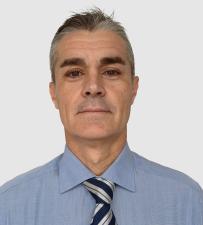Meet Ramon Pérez Zaragoza
Valencia, Spain

When Ramon entered civil engineering school—or “Ingeniero de Caminos, Canales y Puertos”—in Valencia, Spain, he had no idea his natural affinity for challenges would take him around the world—from Africa to Costa Rica to San Francisco, and back again to Spain. Over his 25 years in the business, he’s been involved in almost every kind of engineering there is: roadway, marine/port, water and hydraulic, airport, railway and beyond. Most recently, as Deputy Program Manager/Engineering Lead for the Port of San Francisco Waterfront Resilience Program, he’s been helping to manage a visionary program to reduce seismic and climate change risks along San Francisco’s waterfront.
He finds it rewarding to be part of a profession that is all about making people’s lives easier, whether helping to sustain life—by treating water and protecting the environment—or making it safer and easier for people to move around, whether by car, plane, train, bike or even on foot!
Before all is said and done, Ramon would like to help the industry move the needle on two things. First, rethinking the building materials that’ve been in use for 100 years, things like concrete and steel, instead developing new low-carbon emission building materials, and building in different, more sustainable ways. Secondly, helping bring more life-changing infrastructure to areas in need such as Africa and Latin America. This desire is the result of his having lived in underdeveloped parts of the world and witnessed the quality-of-life disparities between first- and third-world countries.
-
25 +
years in engineering/construction
-
100 +
number of times he's cooked paella
-
100 +
years that his work on the Waterfront Resilience Program will benefit the residents of San Francisco
“I feel extremely lucky to be part of the Port of San Francisco Waterfront Resilience Program …to know that in 30 or 40 years, people will still be enjoying the waterfront and feel protected from sea-level rise and safer during an earthquake.”
Get to know Ramon
Tell us about your role on the San Francisco Waterfront Resiliency Program. What’s your favorite part?
I'm the Deputy Program Manager and Engineering Lead so I manage the teams that work on engineering-related activities and support the engineering lead at the Port of San Francisco (the Port). I get involved in any engineering-related task: design and predesign work, cost estimating, etc., as well as the logistics of keeping the program on track with schedule and budget. I think even though I tend to do more day-to-day management activities than pure engineering activities, I’m an engineer at heart so I like to be in touch with the activities that have to do with pure engineering work. I can tell you I much more enjoy it when I'm in a meeting about engineering topics than about organizing teams and schedules!
My favorite part of the job is participating in the opportunity to transform the City of San Francisco – or at least an important area of the city – with this exciting program. When I talk to people here in Spain, where I now live, about my work on this program, they’re impressed because San Francisco is so well known around the world—everyone knows the Golden Gate Bridge, for example. So, imagine how proud I feel knowing that I'm part of a team that’s helping to make this great city even better, more resilient to the impacts of a big earthquake and future sea-level rise.
Are there any interesting technologies or innovations Jacobs is bringing to the program?
We’re applying all management tools we believe can help the Port move this program forward. Jacobs has created, tested and used so many great tools on other large programs around the world, tools that enable teams to more precisely manage and develop programs. So, while I would say they are unique, they’ve been tested and shown to be effective. As an example, we’ve introduced the Port to a methodology that’s helping them evaluate and select project alternatives, something called “multi-objective decision analysis” or “MODA.” It’s a logical process based on decision analysis that steps clients through multiple, sometimes competing, objectives to arrive at a decision, for example, about which projects to implement first.
What excites you about the future of working on programs like this one for #OurJacobs?
I feel extremely lucky to be part of the Waterfront Resilience Program team and to know that, in some way, in 30 or 40 years, people will still be enjoying the waterfront and feel protected from sea-level rise and safer during an earthquake. It’s great to know that this program will continue to benefit the next generation even if they’ll never know how it came to be. Just thinking about that motivates me to sit down at my laptop every day and get to work. Not everybody can say they’re working on something with this kind of long-term impact.
When you aren’t working, what are we most likely to find you doing?
I love running – I'm a runner. So as long as my body allows me to continue, I’ll keep running! I love also cycling and I love to cook. One of my goals for 2024 is to become an expert at cooking paella, a traditional Spanish dish that originated here in Valencia, where I live, but is now popular all over the world. I'm really practicing hard, trying to learn how to cook it well!
What is your favorite part of working at #OurJacobs?
The opportunity to be part of big projects and having the flexibility that allows me to work from my home. It’s really great to work for a company that trusts you at this level, that allows you to work in a way that also takes into account the needs of family and life outside of work.













































